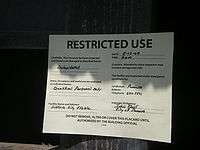Pomona City Stables
|
Pomona City Stable | |
|
Pomona City Stables, August 2008 | |
   | |
| Location | 636 W. Monterey Ave., Pomona, California |
|---|---|
| Coordinates | 34°3′33″N 117°45′31″W / 34.05917°N 117.75861°WCoordinates: 34°3′33″N 117°45′31″W / 34.05917°N 117.75861°W |
| Built | 1909 |
| Architect | Ferdinand Davis |
| Architectural style | Late Victorian |
| NRHP Reference # | [1] |
| Added to NRHP | October 06, 2004 |
The Pomona City Stables, also known as the Pomona City Yards Brick Building, is a stables building completed in 1909 to house horses owned by the City of Pomona, California.
Built at a cost of $6,000, the Pomona City Stables building was designed by Pomona architect Ferdinand Davis from the firm of Davis and Higgs.[2] Davis also designed several other prominent buildings in Pomona, including the Currier House (1907), the Masonic Lodge, the Ebell Club, and Trinity Methodist Church.[3] Located on White Avenue, just north of the Southern Pacific railroad tracks, the Pomona City Stables opened in April 1909 and were described by the Los Angeles Times as "models of convenience" that would provide "ample room for the city stock and implements for some time to come."[2] Upon its opening, the building was occupied by twenty-two head of horses owned by the city and a caretaker.[2]


The building is reported to be one of the oldest municipal buildings extant in California.[4] In 2003, the Pomona Historic Preservation Commission recommended recognition of the stables building as a historic landmark,[5][6] and the building was added to the National Register of Historic Places in October 2004. However, the listing of the building has not led to any cessation of the building's deterioration. Located in the middle of a fenced-off yard used by the City of Pomona for storage of municipal vehicles, fuel, and other materials, the building has fallen into a serious state of disrepair and dilapidation. After the July 2008 Chino Hills earthquake, city officials posted a sign (pictured at left) on the entrance to the stables restricting access due to its dilapidated condition.
See also
References
- ↑ National Park Service (2008-04-15). "National Register Information System". National Register of Historic Places. National Park Service.
- 1 2 3 "City Stables Completed: Pomona's Six-Thousand-Dollar Home for Horses Is Model of Convenience". Los Angeles Times. 1909-04-06.
- ↑ "Pomona's Currier House to be Restored". PreserveLA.com. 2006-10-23.
- ↑ "Other Historic Sites in Pomona". Historical Society of Pomona Valley.
- ↑ "Agenda of Regular Meeting" (PDF). City of Pomona. 2003-08-04.
- ↑ http://pomona.vpi.net/files/planning/historic_preservation_agenda_070203.pdf
